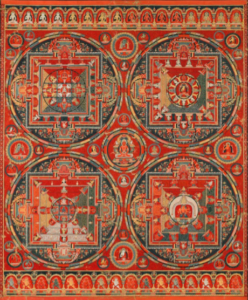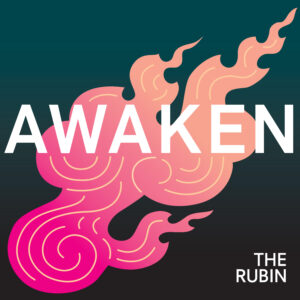
ABOUT THE MEDITATION
Meditation session led by Sharon Salzberg.
The guided meditation begins at 15:58
For centuries Himalayan practitioners have used meditation to quiet the mind, open the heart, calm the nervous system, and increase focus. Now Western scientists, business leaders, and the secular world have embraced meditation as a vital tool for brain health.
Whether you’re a beginner, a dabbler, or a skilled meditator seeking the company of others, join expert teachers in a forty-five-minute weekly program designed to fit into your lunch break. Each session will be inspired by a different work of art from the Rubin Museum’s collection and will include an opening talk, a twenty-minute meditation session, and a closing discussion.
Presented in partnership with Sharon Salzberg and the Interdependence Project. This program is supported in part by the Hemera Foundation.

RELATED ARTWORK

THEME: ACCEPTANCE
Mandalas are utilized by advanced practitioners of Buddhism as visual aids during meditation. They portray the sacred realms of deities, and serve as microcosms of frames of existence.
This exquisite thangka is the 13th painting in a set depicting the 42 mandalas of the Vajravali (Diamond Garland) ritual text. This book of esoteric teachings was the crowning achievement of the 11th-century Indian master Abhayakaragupta. It was widely transmitted in Tibet.
This painting was commissioned by the founder of Ngor Ewam Monastery (1429), in memory of his deceased teacher. Details of this painting’s creation were recorded in Ngor monastic histories, which recount that it was made at Ngor Monastery by six itinerant Newar artists who came from the Kathmandu Valley in Nepal to create it, including the famous artist Wangguli.
Ngor Monastery became particularly famous for such meticulous, intricately painted mandalas—recognizable by a rich red and blue palette highlighted in yellow—that closely followed Newar aesthetics inherited from Nepalese master painters.
Remarkable for its near pristine condition, this painting represents the culmination of Newar artisanship in southern-central Tibet. Although the painting was made by Newari artists, the composition strictly follows Tibetan conventions of imagery and iconography.
ABOUT THE SPEAKER

Sharon Salzberg, cofounder of the Insight Meditation Society in Barre, Massachusetts, has guided meditation retreats worldwide since 1974.
Her latest book is Real Change: Mindfulness to Heal Ourselves and the World. Sharon is also the author of several publications including the New York Times bestseller Real Happiness: The Power of Meditation, Faith: Trusting Your Own Deepest Experience, Lovingkindness: The Revolutionary Art of Happiness, and Real Love: The Art of Mindful Connection. While running her own podcast The Metta Hour and interviewing 100+ influential voices in meditation and mindfulness movements, Sharon has regularly contributed to many onstage conversations at the Rubin.


